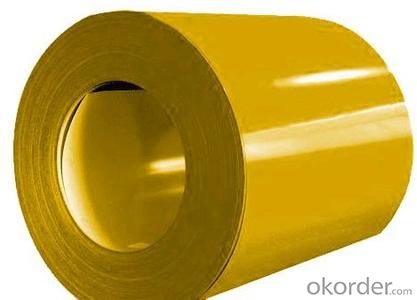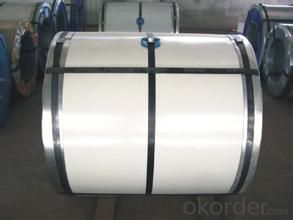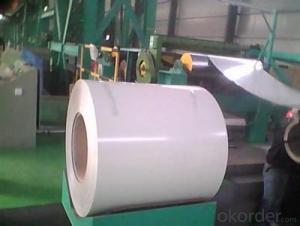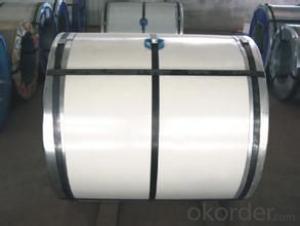Prime Quality Ppgl(prepainted galvalume) Steel Coils
- Loading Port:
- Qingdao
- Payment Terms:
- TT OR LC
- Min Order Qty:
- 100 m.t.
- Supply Capability:
- 20000 m.t./month
OKorder Service Pledge
OKorder Financial Service
You Might Also Like
Prime Quality Ppgl(prepainted galvalume) Steel Coils
1.Structure of Prime Quality Ppgl(prepainted galvalume) Steel Coils
Prime Quality Ppgl(prepainted galvalume) Steel Coils is one kinds of building material on construction.Steel sheet in melting zinc trough, the sticking of a layer of zinc sheet. At present mainly adopts continuous galvanizing process, namely the continuous roll of steel plate in the melt zinc plating tank made of galvanized steel sheet; Alloying of galvanized steel. This kind of steel plate is made by hot dip method, but after the slot, immediately heated to a temperature of about 500 ℃, it make the generation of zinc and iron alloy membrane. This kind of galvanized volumes with good coating of the sex and weldability.
Color coated steel coil(ppgi) is made by the processes of chemical preconditioning, first coating, precision coating and so on through a continuous rapid unit internationally in recent three decades. Its quality is more uniform and stable than the one whose surface of the formed metal is coated single or brushed one.
2.Main Features of Prime Quality Ppgl(prepainted galvalume) Steel Coils.
1) Rust-proof
2) Water-proof
3)Durable using
3. Prime Quality Ppgl(prepainted galvalume) Steel Coils Images


4. Prime Quality Ppgl(prepainted galvalume) Steel Coils Specification
1) prepainted galvalume steel roll Can be coated as per customers' requests
2) Specifications of the prepainted galvalume steel roll:
A) Thickness of Color Coated steel roll: 0.18-0.8mm
B) Width of Color Coated steel roll: 800-1250mm
C) The specifications of Color Coated steel roll also can be as per customers' requests
3) Grade: Q195, SPCC, SPCD
4)Payment terms: T/T, L/C
5)PriceTerms: FOB, CFR, CIF
Special Requirements of the prepainted galvalume steel roll can be negotiated.
5.FAQ of Prime Quality Ppgl(prepainted galvalume) Steel Coils
We have organized several common questions for our clients,may help you sincerely:
①How about your company?
A world class manufacturer & supplier of castings forging in carbon steel and alloy steel,is one of the large-scale professional investment casting production bases in China,consisting of both casting foundry forging and machining factory. Annually more than 8000 tons Precision casting and forging parts are exported to markets in Europe,America and Japan. OEM casting and forging service available according to customer’s requirements.
②How to guarantee the quality of the products?
We have established the international advanced quality management system,every link from raw material to final product we have strict quality test;We resolutely put an end to unqualified products flowing into the market. At the same time, we will provide necessary follow-up service assurance.
③How is the shipping arrangement?
We normally use shippping by containers..
- Q:What are the different methods of joining steel coils?
- There are several methods of joining steel coils, including welding, using mechanical fasteners, and adhesive bonding. Welding is a common technique that involves melting and fusing the edges of the coils together using heat. Mechanical fasteners, such as bolts or screws, can also be used to secure the coils together. Additionally, adhesive bonding involves using a strong adhesive to bond the coils together. Each method has its own advantages and considerations depending on the specific application and requirements.
- Q:What are the different types of steel coil surface treatments for durability?
- The durability of the material can be enhanced through various types of steel coil surface treatments. 1. To achieve a protective zinc coating on the surface, the steel coil is immersed in a bath of molten zinc in the process of hot-dip galvanizing. This method not only provides excellent corrosion resistance but also extends the lifespan of the steel coil. 2. For indoor applications or when a thinner coating is desired, electro-galvanizing is preferred. This method involves electrodeposition of a thin layer of zinc onto the surface of the steel coil, offering good corrosion resistance. 3. By applying a dry powder paint to the steel coil's surface and curing it under heat, powder coating creates a durable and attractive finish. This finish is resistant to chipping, scratching, and fading, ensuring a uniform appearance. 4. To protect against corrosion, UV rays, and other environmental factors, organic coatings like acrylics, polyesters, or fluoropolymers are commonly applied to steel coils. These coatings not only enhance durability but also improve the aesthetics of the steel coil. 5. Chromate conversion coating involves applying a thin layer of chromate onto the steel coil's surface. This treatment provides corrosion resistance and improves the adhesion of subsequent paint or powder coating layers. Each of these surface treatments offers unique benefits in terms of corrosion resistance, durability, and appearance. The choice of treatment depends on the specific application requirements and the level of protection needed for the steel coil.
- Q:Edward Humphrey wants to know... Can I use steel roofing on an older house?
- ed like others have said yes you can and its relatively simple to do. ? is it steal you want or would to plastic they call it work. we've done several around here in central Illinois and we've done both. as far as putting boards under the metal we've only done that on one, usally you start at a bottom corner, work your way across the roof and up just as you do shingles, remember though unlike shingles these don't have any sealing strips, so under each overlap before putting the piece on you need to put a sealer bead on. the tubes from your local lumber yard work just fine. just remember dont hurry yourself into making mistakes and forgetting anything. i don't know if you have helpers but generally you can hire a high school kid to help put this on. it isn't really that hard.use whats called a barn screw to hold it onto your existing roof,( they are color coated, and have rubber gaskets) so no leaks where fastened unlike nails.
- Q:I need steel toe shoes for a workplace, where can I get them?I live in Surrey,UK.
- steel okorder
- Q:What are the main factors that affect the flatness of steel coils?
- The main factors that affect the flatness of steel coils are the quality and thickness of the steel material, the tension and speed of the rolling process, the temperature and cooling rate during the cooling process, and any potential defects or imperfections in the machinery used for rolling and cooling the steel coils.
- Q:What are the different types of steel coil slitting lines?
- In the metal processing industry, various types of steel coil slitting lines are utilized to cut large coils of steel into narrower strips for different applications. 1. Loop Slitting Lines: The industry commonly employs loop slitting lines, which consist of a decoiler to hold the coil, a slitter head for cutting the coil into strips, and a recoiler to wind the strips into smaller coils. These lines are versatile and can handle different coil widths and thicknesses. 2. Scrap Chopper Slitting Lines: Similar to loop slitting lines, scrap chopper slitting lines incorporate a scrap chopper unit. This unit eliminates excess material from the coil edges before slitting, enhancing efficiency and reducing waste. 3. Double Loop Slitting Lines: For high-speed slitting of thin-gauge coils, double loop slitting lines are utilized. These lines feature two looping pits, enabling continuous operation. While one coil is processed, the other is prepared for slitting, minimizing downtime. 4. Turret Head Slitting Lines: Designed for high-volume production, turret head slitting lines can process multiple coils simultaneously. They are equipped with a turret head containing multiple slitter knives that can be swiftly rotated to switch between different coil widths, resulting in faster and more efficient production. 5. Rotary Shear Slitting Lines: Rotary shear slitting lines are suitable for thicker and harder materials. Instead of a slitter head, they employ a rotary shear to cut the coil into strips. The rotary shear offers improved cutting performance and can handle higher tensile strength materials. 6. Combination Slitting Lines: Combination slitting lines are versatile machines that can handle various materials and perform both slitting and cut-to-length operations. They are ideal for smaller manufacturers or those requiring flexibility in their production process. Ultimately, the choice of steel coil slitting line depends on the manufacturer's specific requirements, including the type of material, desired strip width, and production volume.
- Q:Is Carbon Steel strong for swords?
- Depends on the sword design. Some swords are high carbon, some a low carbon, some are made from a billet of alternating high and low carbon ('Damascus' steels). It all depends on what characteristics you want for your sword. Softer steels won't hold an edge as well but they offer great flexibility so your sword won't shatter when they make impact with armor or shields. Harder steels hold better edges but they're prone to binding in wooden shields and then being broken as soon as a bending force is applied along the weak axis of the blade. Japanese Katanas have both hard and soft steels to allow the blade to bend yet still hold strong edges. If you're making the sword from raw materials on your own, look up some different recipes for crucible steel. It's probably the most fun and involved process.
- Q:The Iron and Steel Corporation of Great Britain (1949) or Iron and Steel Bill was introduced in 1949 during the Labour post-war Government.What was it introduced for?
- It was a holding company that originally had 107 companies who manufactured iron or steel products in Great Britain.
- Q:How long can steel coils be stored?
- Steel coils can be stored for an extended period, typically up to six months to a year, depending on the specific type of steel and its storage conditions.
- Q:I'm talking about the sort of carbon fiber that's used in the auto industry (mostly in supercars).If an object made of steel were to be copied by an exact same object, but made of carbon fiber - how lighter would the carbon fiber object be?For example, if a table is made of steel and it weighs X, how much will it weigh if it were made of carbon fiber?Thanks.
- by 6L8
1. Manufacturer Overview |
|
|---|---|
| Location | |
| Year Established | |
| Annual Output Value | |
| Main Markets | |
| Company Certifications | |
2. Manufacturer Certificates |
|
|---|---|
| a) Certification Name | |
| Range | |
| Reference | |
| Validity Period | |
3. Manufacturer Capability |
|
|---|---|
| a)Trade Capacity | |
| Nearest Port | |
| Export Percentage | |
| No.of Employees in Trade Department | |
| Language Spoken: | |
| b)Factory Information | |
| Factory Size: | |
| No. of Production Lines | |
| Contract Manufacturing | |
| Product Price Range | |
Send your message to us
Prime Quality Ppgl(prepainted galvalume) Steel Coils
- Loading Port:
- Qingdao
- Payment Terms:
- TT OR LC
- Min Order Qty:
- 100 m.t.
- Supply Capability:
- 20000 m.t./month
OKorder Service Pledge
OKorder Financial Service
Similar products
New products
Hot products
Related keywords




























